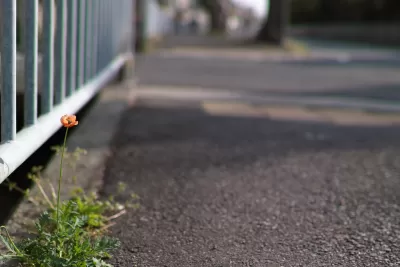Paved surfaces take up close to a third of space in U.S. cities, polluting waterways and contributing to the urban heat island effect.

As planners reevaluate the impacts of urban freeways and work to undo the damage done to urban neighborhoods, writes Mary Pat McGuire, they should also consider "another harmful infrastructure" that has, in many cases, taken over much urban space: "the extraordinary amount of pavement in U.S. cities that has come to characterize urban life."
Taking up 30% of city surfaces, pavement "pollutes waterways through rapid run-off, generates flooding in neighborhoods, and activates temperature rise through the urban heat island effect." As such, planners should look for ways to remove pavement in favor of healthier alternatives.
Approximately 93% of roads are paved with asphalt. Asphalt is a 19th-century technology which is impervious to stormwater, includes a crude oil binder, and releases harmful air pollutants and carcinogens. The human impact is felt through urban flooding, heat waves, and respiratory health problems. Notably, the distribution of that pavement is disproportionately felt by the absence of shade trees in low-income areas.
"Given that we have more streets and parking than truly needed, removal of this harmful infrastructure is a necessary part of urban adaptation and climate justice." But removing pavement requires a different approach than freeway removal, McGuire writes. "Somewhat different from a single highway coming out, depaving city streets and parking lots entails a more distributed, systemic approach." Successful examples include "initiatives like Depave in Portland and Space to Grow in Chicago," which "have worked with numerous schools in each respective city to transform asphalt playgrounds into gardens and stormwater surfaces, reconnecting people with land and with each other."
In spite of historic resistance to the removal of infrastructure, "the severe impact of highways and pavements on the health of land, water, and people are giving us a reason to adopt a new way of thinking, as did the height of the pandemic in the U.S. when streets were appropriated for cafes and neighborhood events. In depaving our cities, we can imagine how to make those social spaces permanent — and environmentally sustainable."
FULL STORY: While We’re Considering Removing Highways, Let’s Not Overlook Pavement

Trump Administration Could Effectively End Housing Voucher Program
Federal officials are eyeing major cuts to the Section 8 program that helps millions of low-income households pay rent.

Planetizen Federal Action Tracker
A weekly monitor of how Trump’s orders and actions are impacting planners and planning in America.

Ken Jennings Launches Transit Web Series
The Jeopardy champ wants you to ride public transit.

Washington Legislature Passes Rent Increase Cap
A bill that caps rent increases at 7 percent plus inflation is headed to the governor’s desk.

From Planning to Action: How LA County Is Rethinking Climate Resilience
Chief Sustainability Officer Rita Kampalath outlines the County’s shift from planning to implementation in its climate resilience efforts, emphasizing cross-departmental coordination, updated recovery strategies, and the need for flexible funding.

New Mexico Aging Department Commits to Helping Seniors Age ‘In Place’ and ‘Autonomously’ in New Draft Plan
As New Mexico’s population of seniors continues to grow, the state’s aging department is proposing expanded initiatives to help seniors maintain their autonomy while also supporting family caregivers.
Urban Design for Planners 1: Software Tools
This six-course series explores essential urban design concepts using open source software and equips planners with the tools they need to participate fully in the urban design process.
Planning for Universal Design
Learn the tools for implementing Universal Design in planning regulations.
Heyer Gruel & Associates PA
Ada County Highway District
Institute for Housing and Urban Development Studies (IHS)
City of Grandview
Harvard GSD Executive Education
Toledo-Lucas County Plan Commissions
Salt Lake City
NYU Wagner Graduate School of Public Service


























